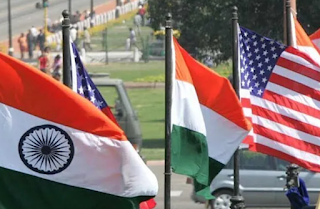Indian and U.S. officials are set to engage in three days of crucial trade talks starting from April 23 in Washington, focused on a proposed trade pact between the two countries. These discussions will cover approximately 19 chapters, addressing key areas such as tariffs, non-tariff barriers, and customs facilitation, according to official sources. The aim is to solidify terms of reference (ToRs) that will lay the groundwork for a potential bilateral trade agreement (BTA). The upcoming meetings will provide a platform for ironing out any differences on specific issues before both sides formally launch full-fledged negotiations.
The Indian delegation, led by Rajesh Agrawal, Additional Secretary in the Department of Commerce, will represent India in these in-person talks. Agrawal, appointed as the next Commerce Secretary on April 18, will officially assume office on October 1. During this session, both sides will delve into various facets of the trade pact, including the "level of ambition" and the future pathway for the talks. The ToRs will include discussions on critical topics like rules of origin, goods and services, regulatory frameworks, and custom facilitation, among others. Agrawal and his team are expected to work closely with U.S. officials to ensure the smooth development of the ToRs, addressing contentious issues and setting up a firm schedule for the rest of the discussions.
This three-day dialogue is particularly significant given the recently announced 90-day tariff pause by U.S. President Donald Trump, which allows both countries a window to accelerate the trade talks. U.S. officials have expressed hopes that this temporary suspension of tariffs could lead to a mutually beneficial interim trade agreement if both parties can find common ground. The “level of ambition” in international trade refers to the willingness of both countries to commit to liberalizing specific trade areas, including goods and services, which will play a crucial role in shaping the trade pact’s final structure.
The bilateral trade discussions between India and the U.S. have been ongoing since March, and the key objective for both sides is to finalize the first phase of the trade agreement by the fall of 2025. The overarching goal of this pact is to significantly boost bilateral trade, with a target to more than double trade volumes to $500 billion by 2030. Currently, trade between the two countries stands at approximately $191 billion, and both parties are eager to expand their commercial ties.
In terms of specifics, the U.S. is pushing for tariff reductions on sectors like industrial goods, electric vehicles (EVs), wines, petrochemicals, dairy products, and agricultural items such as apples, tree nuts, and alfalfa hay. On the other hand, India is seeking tariff cuts in sectors that are labor-intensive, such as textiles, apparel, gems and jewelry, leather, plastics, and shrimp. Other sectors on India’s radar for duty cuts include chemicals, oilseeds, and horticulture products.
India has been one of the largest trading partners of the U.S. in recent years. As of fiscal year 2024, India enjoyed a trade surplus of $41.18 billion with the U.S., with Indian exports to the U.S. rising by 11.6% to $86.51 billion. U.S. imports into India increased by 7.44% in 2024-25, totaling $45.33 billion. The U.S. accounted for nearly 19.78% of India’s total exports, reflecting the growing significance of this economic relationship.
This ongoing effort to deepen trade relations is also seen in the context of the Trump administration’s recent tariffs. On April 2, the U.S. had announced sweeping tariffs, including a 26% tariff on India, which was later suspended for a 90-day period. This temporary reprieve gives both countries a chance to finalize discussions and implement a more comprehensive trade framework.
For India, the major exports to the U.S. in 2024 included drug formulations, telecom instruments, precious and semi-precious stones, petroleum products, gold, ready-made garments, and iron and steel products. Meanwhile, key imports from the U.S. included crude oil, coal, electric machinery, aircraft parts, and gold. India’s strong export performance to the U.S. highlights the significant role the country plays in global trade, while the U.S. continues to be a vital supplier of goods, particularly in the energy and technology sectors.
Looking ahead, the trade discussions will also need to address the strategic shift in global trade dynamics, as countries like India seek to bolster their manufacturing sectors and reduce reliance on imports from other markets. The trade pact between India and the U.S. is expected to serve as a foundational step in shaping the future of global trade relations, with both nations aiming to maximize their respective benefits from the deal.
These talks will not only have an immediate impact on tariffs and market access but also on long-term economic growth, as both countries seek to capitalize on each other's strengths in technology, manufacturing, and services.



